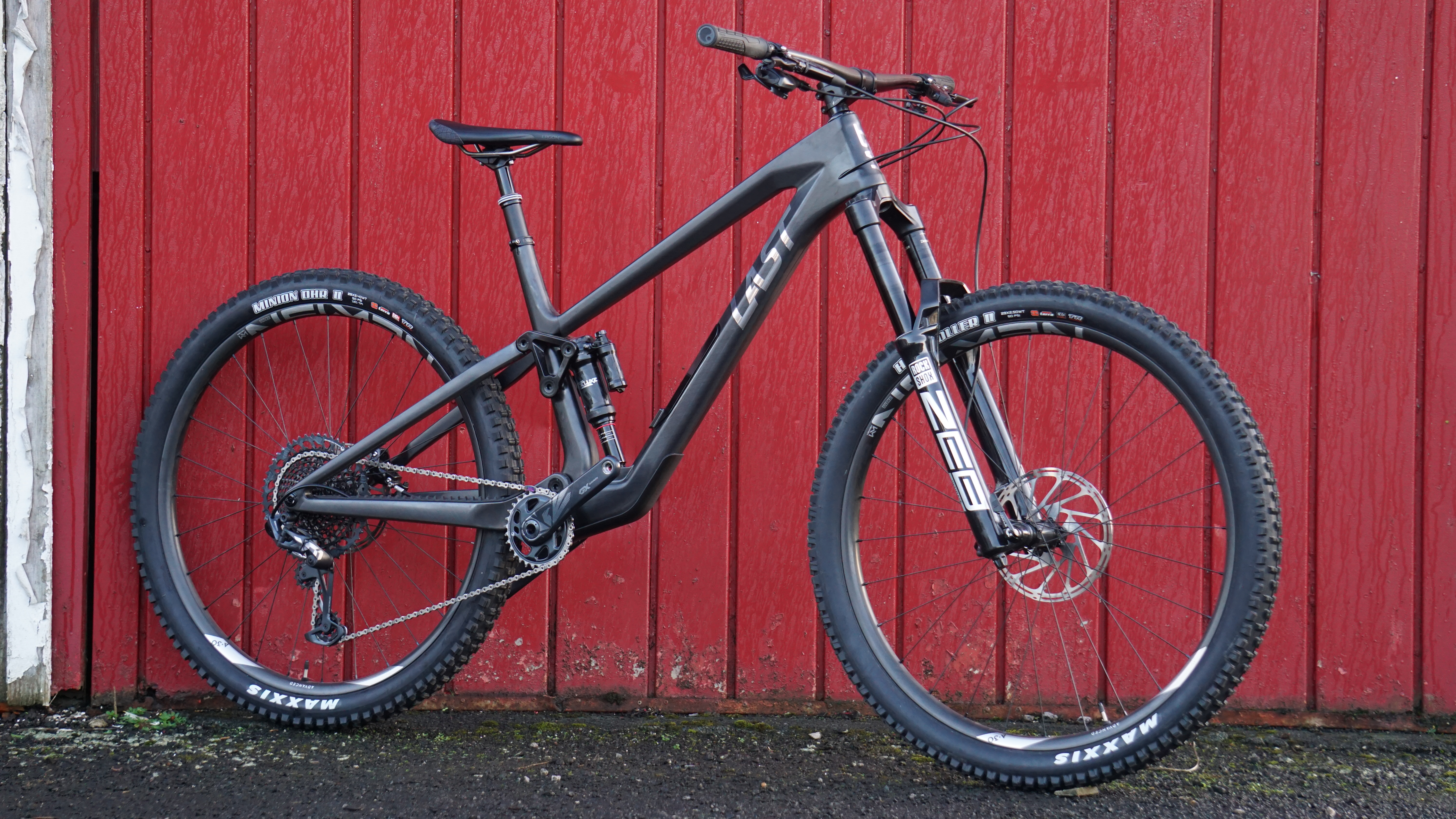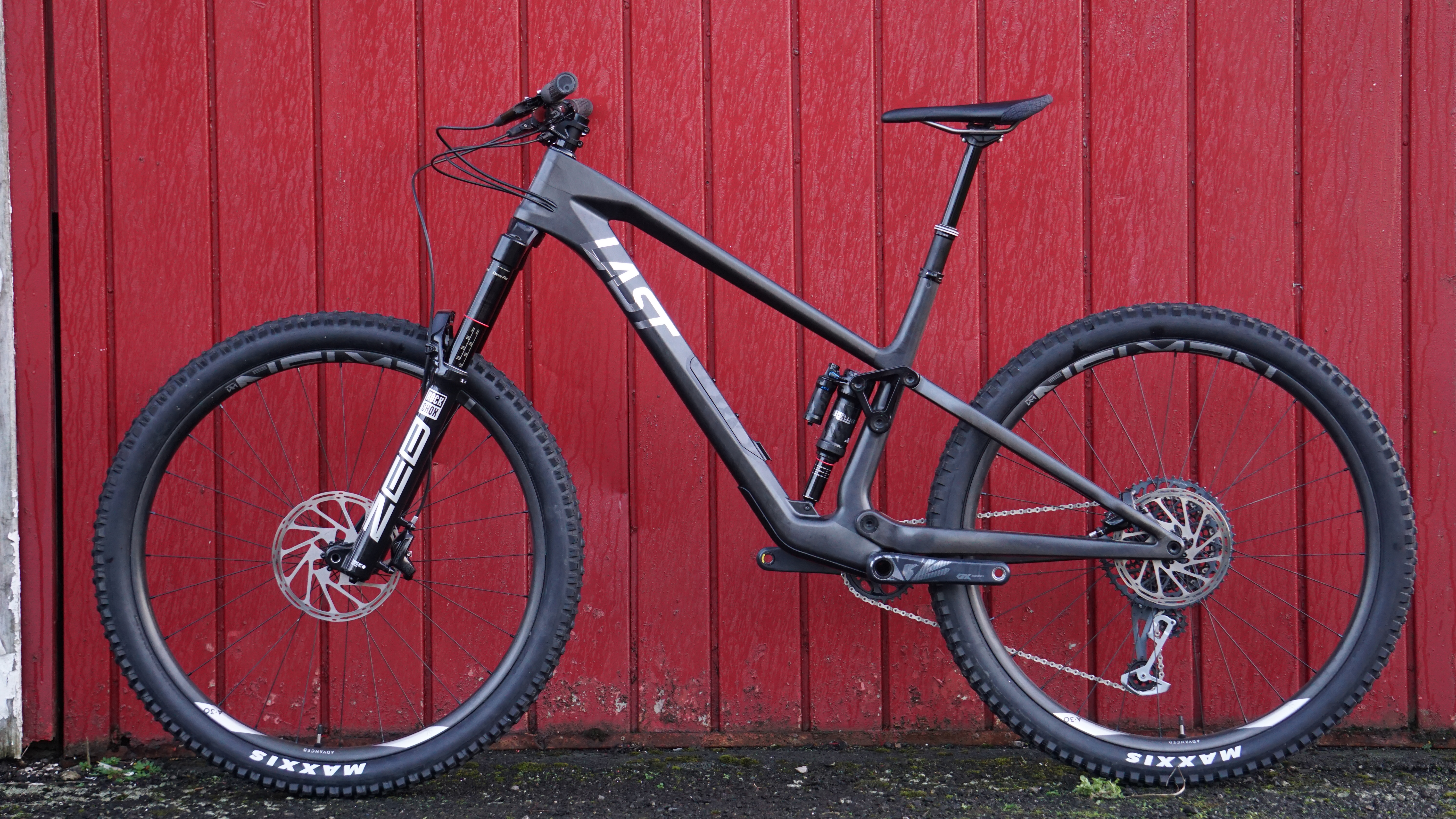The Last Tarvo with its progressive geometry, stable pedal platform and predictable handling is certainly capable of a podium or two.
This review first appeared in Singletrack World Magazine issue 138
- Brand: Last
- Product: Tarvo
- Price: Full builds start at €6,469.00, frame-only €3,999.00
- From: Last Bikes
- Review by: Ross for Issue 138

Last is a German bike brand that might not be so familiar to riders in the UK, but it’s one we’ve been watching for some time now. The first time we remember them really catching our attention was way back in the early days of aggressive 29ers. Back then there were very few really radical hardtails that used larger 29er hoops, so when Last launched the Fast Forward we were instantly impressed. It wasn’t just us who loved the Fast Forward though – testers around the world loved the slack steel hardtail, heralding it as ‘full-suspension fast’ in the right conditions.
The Fast Forward went through a couple of revisions, but seems to have disappeared from the range and been replaced with some pretty cool looking full suspension bikes. For a couple of years the Last full suspension consisted of the Coal, a 27.5in bike with a single pivot rear end but with a yoke and linkage driven shock. The Coal continues and has now been joined by the Glen using a similar suspension platform, but 29in wheels.
Now, though, the Tarvo has entered the range and, as good as those alloy bikes still look, this carbon beauty really is something else. It’s so good that I’m surprised not more people, media and magazines aren’t talking about it, but then again I’m also happy that this bike has flown under most people’s radar as it gives us a semi-exclusive.
So, why are we so excited about the Tarvo – it’s just another carbon enduro bike, isn’t it? No, it’s actually the world’s lightest (claimed) enduro bike! It’s also handmade in Germany, built to crazy tolerances, and is probably the bike many of us would draw if we were to describe our dream bike. Who doesn’t want an ultra-lightweight 29er with a Zeb up front?











The Bike
We’ve heard people say it’s really easy to make something extremely complicated that isn’t very good, but it takes some real skill, knowledge and know-how to build something that’s simple, but works really well. The Last Tarvo is a perfect example of this. Compared to the Glen and Coal, the rear suspension layout of the Tarvo is ultra-simple, settling for a single rocker and main pivot rather a bunch of additional linkages. It is so simple that Last has even stripped the pivot from the chainstay/seatstay intersection altogether and replaced it with a flex-stay arrangement, something more common on XC rigs rather than enduro race weapons.
The one word that springs to mind when looking at the Last in detail is ‘clean’. It’s by far the most simple, clean, and elegant enduro frame we’ve laid our eyes on for some time, yet it manages to be really clever and complicated at the same time. Last didn’t simply set out to make another cookie-cutter carbon bike, but something that’s a cut above the rest, not only in terms of performance and weight, but how the bike is made and that meant thinking responsibly. Last wanted to ensure that the materials and processes used in the construction of the Tarvo met its responsibility and ecological requirements, which is why the carbon fibres used in the frame comes from Japan and the process of pre-impregnation is handled by a company in Italy. While we don’t know what that means for the carbon footprint of a Tarvo frame, at least we can be pretty sure those factories are a safe environment for the workers. All of that carbon then lands at All Ahead in Würzburg where the wonder weave is laid up in custom one-piece moulds. While some manufacturers will build their carbon frames as tubes and lugs still, the Tarvo is made in two halves of a mould to ensure a precise and strong construction with consistent wall thicknesses. Not only does this mean the Tarvo is strong (it’s tested to meet strict safety standards), but it also ensures each Tarvo uses only as much carbon as it needs, saving waste and ensuring a low weight.
It’s not simply a process of laying carbon in moulds then glueing the two halves together though. All Ahead places the mould under high pressure and creates a vacuum inside the mould so that any air is removed and no air pockets are allowed to form.
So it’s built smartly, but the rest of the bike is super smart too. The suspension uses a size-specific, anti-squat kinematic, meaning that each size of frame has its pivot points in a different location. Then there’s the internal frame bladder that gives you storage in the downtube cavity, there’s the ability to run it as either a 29er or a mullet and then, of course, is the light weight. Last states a Tarvo carbon frame weighs only 4.6lbs while bikes weigh as little as 25.5lbs. And that’s for a 170mm travel 29er enduro bike!

The Ride
Jumping on the Tarvo for the first time, it has an air of purposefulness about it. The slack 64° head angle and stealth-fighter-esque frame make it look and feel like it wants to go fast. Picking it up, the low weight – 13.3kg – is immediately noticeable and once you get the pedals turning there is a good, efficient feeling. Road and flat sections are dispatched with ease with the Tarvo picking up and maintaining speed well.
Once you hit the trails and the gradient starts going up, the efficient pedalling and light weight again start to show themselves. For a 170mm forked, 160mm travel enduro bike the Tarvo climbs really well and has a sprightly feel that you don’t always get with bigger bikes.
Set up at 30% sag, I never felt the need to reach for the platform switch on the Super Deluxe shock, with the suspension doing a great job of smoothing out the trail, without ever feeling wallowy or showing any noticeable pedal bob.
The 76.2° seat angle, while not overly steep by modern standards, puts you in a comfortable position for racking up the miles, while also allowing you to get your weight over the front on steeper climbs to stop the front from wandering. Technical climbing is good, with the rear end doing a great job of keeping traction on loose surfaces while still being supportive, letting you claw your way up steep inclines, and the light weight helps when having to manoeuvre the bike over mid-trail obstacles.
Once you’ve got all your climbing out of the way and the trail starts pointing down is when the Tarvo really starts to shine. While it might have nice mild manners when pedalling up, add a bit of gravity into the mix and the Tarvo starts to show its true colours…
Getting off the brakes and letting the bike run, the long wheelbase and slack head angle add up to plenty of high-speed stability, letting you push on in rough and rocky terrain. The rear end does an amazing job of soaking up hits, while still remaining supportive for loading up and gapping sections or boosting off lips.
Combined with the top-end ZEB Ultimate up front, it adds an element of calmness to descending, and before you know it you’re approaching warp speed and basically seeing how long you dare to not touch the brakes. And while it’s definitely a ‘big’ bike, it’s also an easy bike to ride.
It’s nice and quiet with no angry bees from the Fade rear hub and there are no distracting rattles from the frame – until you add a water bottle. The cage mounts on to the access panel to the in-frame storage, which is only held in place by a magnet so adding a full water bottle does end up with a bit of chatter.
On steeper tracks the Tarvo’s geometry adds confidence, letting you stay centred on the bike without the need to hang off the back. This in turn adds grip to both ends, letting you push hard into fast or steep turns and ruts, using just a shift in body weight to drift the back end round. Whether you prefer railing the outside of turns or drifting the inside, the Tarvo is happy to do it, with the sorted geometry and supportive rear end letting you just pick your line and go with it.

Overall
There’s no doubt that the Tarvo is built for going fast – just get off the brakes and see how it picks up and carries speed – but with its up-to-date geo, and supple, yet supportive rear end, it’s also a fun bike to ride. The Tarvo is amazingly fast when you let it run and I certainly reached my limit of straight-line speed before it did.
Combine this with the light weight, and good pedalling characteristics and it makes the Tarvo a bit more of an all-rounder. OK, not everyone is going to want a 170mm fork and 64° head angle for their daily driver, but if you’re the ‘one bike to do it all’ sort of person and are looking for a bike that can be ridden and raced on the steepest, nastiest enduro and downhill tracks, yet can be pedalled around your local cross-country loops, then the Tarvo should be on your list.

Geometry of our size 185 test bike
- Head angle // 64°
- Effective seat angle // 76.2°
- Seat tube length // 455mm
- Head tube length // 120mm
- Chainstay // 438mm
- Wheelbase // 1,268mm
- Effective top tube // 642mm
- BB height // 27mm BB drop
- Reach // 485mm





